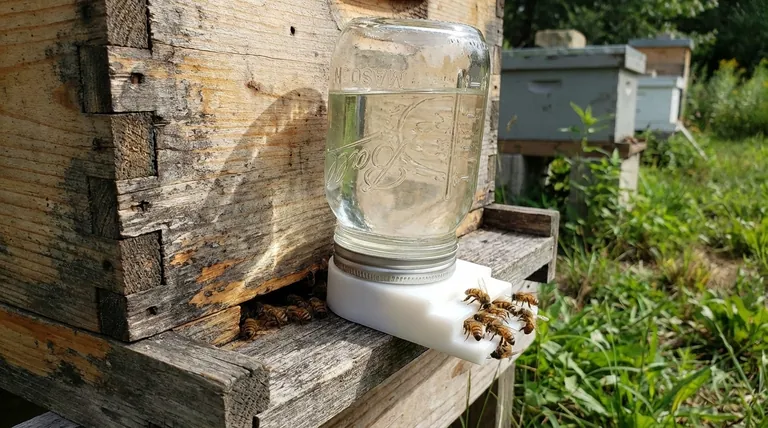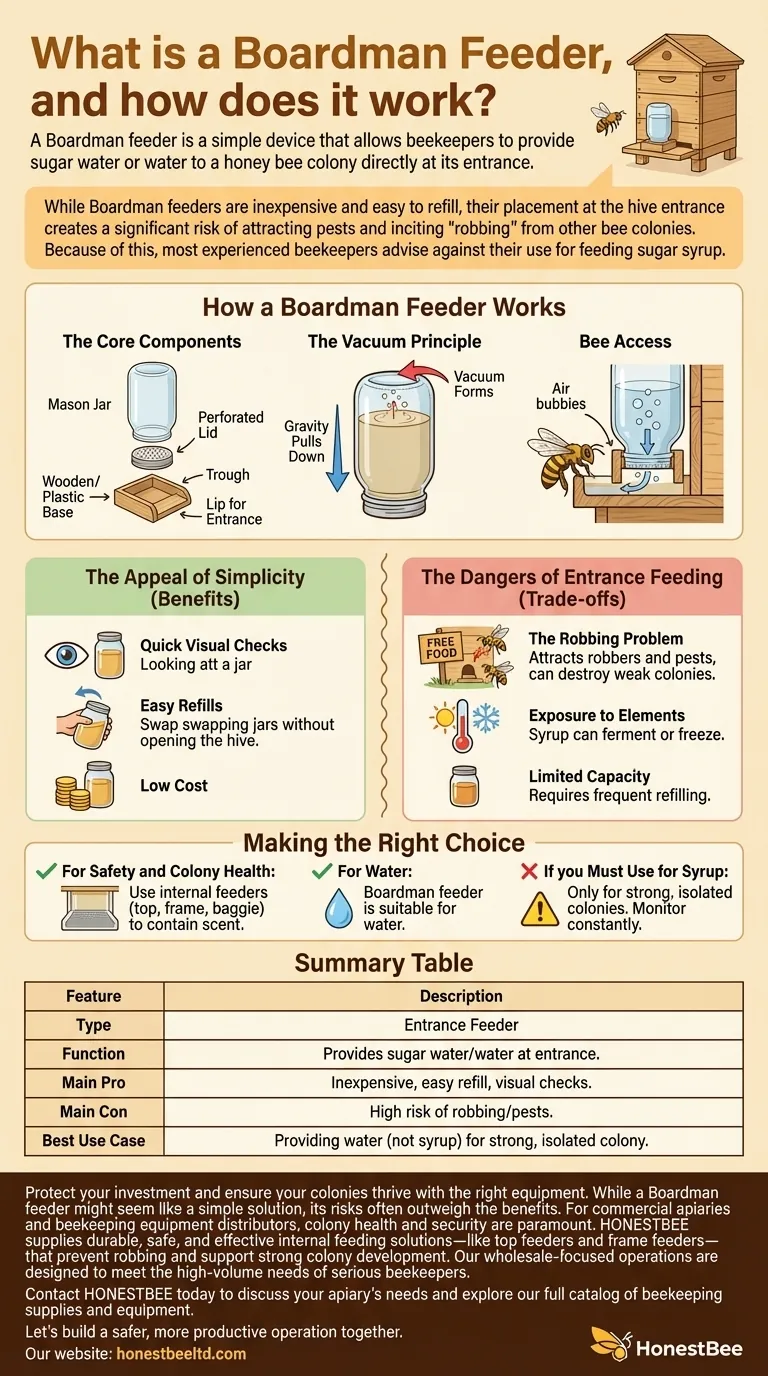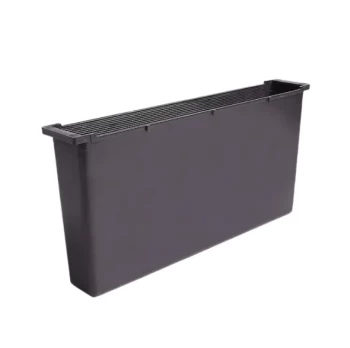A Boardman feeder is a simple device that allows beekeepers to provide sugar water or water to a honey bee colony directly at its entrance. Also known as an entrance feeder, it consists of an inverted jar with a perforated lid that sits on a small base, which is inserted into the hive's front opening. Bees can then access the liquid from a trough in the base.
While Boardman feeders are inexpensive and easy to refill, their placement at the hive entrance creates a significant risk of attracting pests and inciting "robbing" from other bee colonies. Because of this, most experienced beekeepers advise against their use for feeding sugar syrup.

How a Boardman Feeder Works
The feeder's design is straightforward, relying on basic physics and the structure of the hive entrance.
The Core Components
A Boardman feeder has two main parts: a standard screw-top jar (like a mason jar) with small holes punched in the lid, and a wooden or plastic base. The base has a trough for the liquid and a lip that slides into the hive entrance.
The Vacuum Principle
The jar is filled with liquid, the perforated lid is attached, and the entire unit is quickly inverted onto the base. Gravity pulls the liquid down, but a vacuum forms at the top of the jar, preventing the liquid from pouring out all at once.
Bee Access
Bees crawl from the hive into the covered portion of the feeder's base. As they drink the syrup, air bubbles enter the jar through the holes, releasing a small, corresponding amount of liquid to refill the trough.
The Appeal of Simplicity
Despite their drawbacks, Boardman feeders remain available because they offer a few clear benefits, especially for new beekeepers.
Quick Visual Checks
The feeder's glass jar sits on the outside of the hive. This allows you to see exactly how much feed is left with just a glance, without needing to disturb the colony.
Easy Refills
To refill the feeder, you simply swap the empty jar for a full one. This process is fast and can be done without opening the hive, which minimizes stress on the bees.
Low Cost
Boardman feeders are inexpensive, and they utilize common mason jars that many people already own, making them one of the most accessible feeding options.
Understanding the Trade-offs: The Dangers of Entrance Feeding
The convenience of a Boardman feeder comes at a high price. Its design creates several significant problems that can harm or even destroy a colony.
The Robbing Problem
This is the most critical flaw. Placing sugar syrup at the hive's entrance is like putting a "Free Food" sign on the front door. It attracts bees from other hives, as well as wasps and ants.
This can trigger robbing, a frenzy where invaders attack the colony to steal its resources. A robbing event is violent, can kill a queen, and often leads to the complete collapse of the weaker hive.
Exposure to the Elements
The syrup in an external feeder is exposed to ambient temperatures. In cool weather, the syrup becomes too cold for the bees to consume effectively. In hot, direct sun, the syrup can ferment.
Limited Capacity
A typical mason jar holds a relatively small amount of syrup. For a large, growing colony, this may only last a day or less, requiring constant refilling and increasing the risk of the feeder running dry.
Making the Right Choice for Your Bees
Your decision to use a feeder should be based on a risk-versus-reward analysis for your specific situation.
- If your primary focus is safety and colony health: Avoid Boardman feeders for sugar syrup. Use internal feeders like top feeders, frame feeders, or even simple baggie feeders, which keep the syrup's scent contained within the hive.
- If you need to provide a water source: A Boardman feeder is a reasonable choice for water. Plain water does not attract robbers the way sugar syrup does, making it a safe and convenient watering station.
- If you absolutely must use one for syrup: Only do so on a very strong, populous colony in an isolated area with no other hives nearby. Monitor it constantly for signs of robbing and remove it immediately if you see fighting at the entrance.
Ultimately, choosing the right feeder means prioritizing the long-term security of your colony over short-term convenience.
Summary Table:
| Feature | Description |
|---|---|
| Type | Entrance Feeder |
| Function | Provides sugar water or water directly at the hive entrance. |
| Main Pro | Inexpensive, easy to refill, and allows for quick visual checks. |
| Main Con | High risk of attracting pests and inciting robbing from other colonies. |
| Best Use Case | Providing water, not sugar syrup, for a strong, isolated colony. |
Protect your investment and ensure your colonies thrive with the right equipment.
While a Boardman feeder might seem like a simple solution, its risks often outweigh the benefits. For commercial apiaries and beekeeping equipment distributors, colony health and security are paramount.
HONESTBEE supplies durable, safe, and effective internal feeding solutions—like top feeders and frame feeders—that prevent robbing and support strong colony development. Our wholesale-focused operations are designed to meet the high-volume needs of serious beekeepers.
Contact HONESTBEE today to discuss your apiary's needs and explore our full catalog of beekeeping supplies and equipment. Let's build a safer, more productive operation together.
Visual Guide

Related Products
- Classic Boardman Entrance Bee Feeder Hive Front Feeding Solution
- HONESTBEE Entrance Bee Feeder Efficient Hive Front Liquid Feeding Solution for Beekeeping
- Boardman Entrance Bee Feeder Durable Galvanized Steel and Wood Construction for Beekeeping
- HONESTBEE Entrance Bee Feeder Professional Hive Nutrition Solution for Beekeeping
- Rapid Bee Feeder White Plastic 2L Round Top Feeder for 8 or 10-Frame Bee Hives
People Also Ask
- How do you make an entrance feeder for bees? A Guide to Safe & Effective Hive Feeding
- What is a common problem with hive front feeders? Avoid Robbing Frenzies and Protect Your Hives
- How can a Boardman Feeder be used to provide water to bees? Avoid These Critical Risks to Your Hive
- How to make an entrance feeder for bees? A DIY Guide for Safe & Effective Feeding
- How quickly does a medium to strong colony usually empty a feeder? A Beekeeper's Guide to Hive Health



















